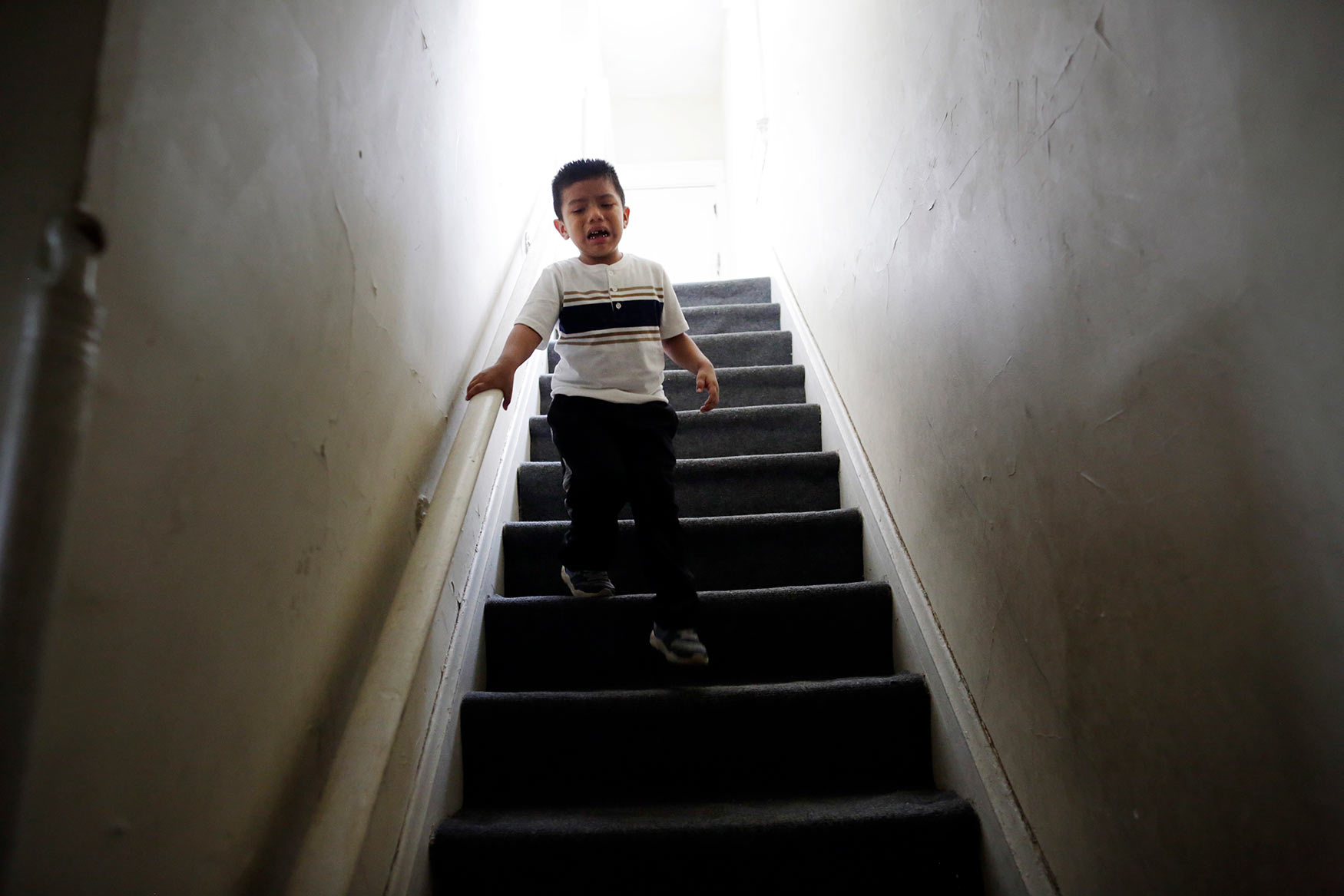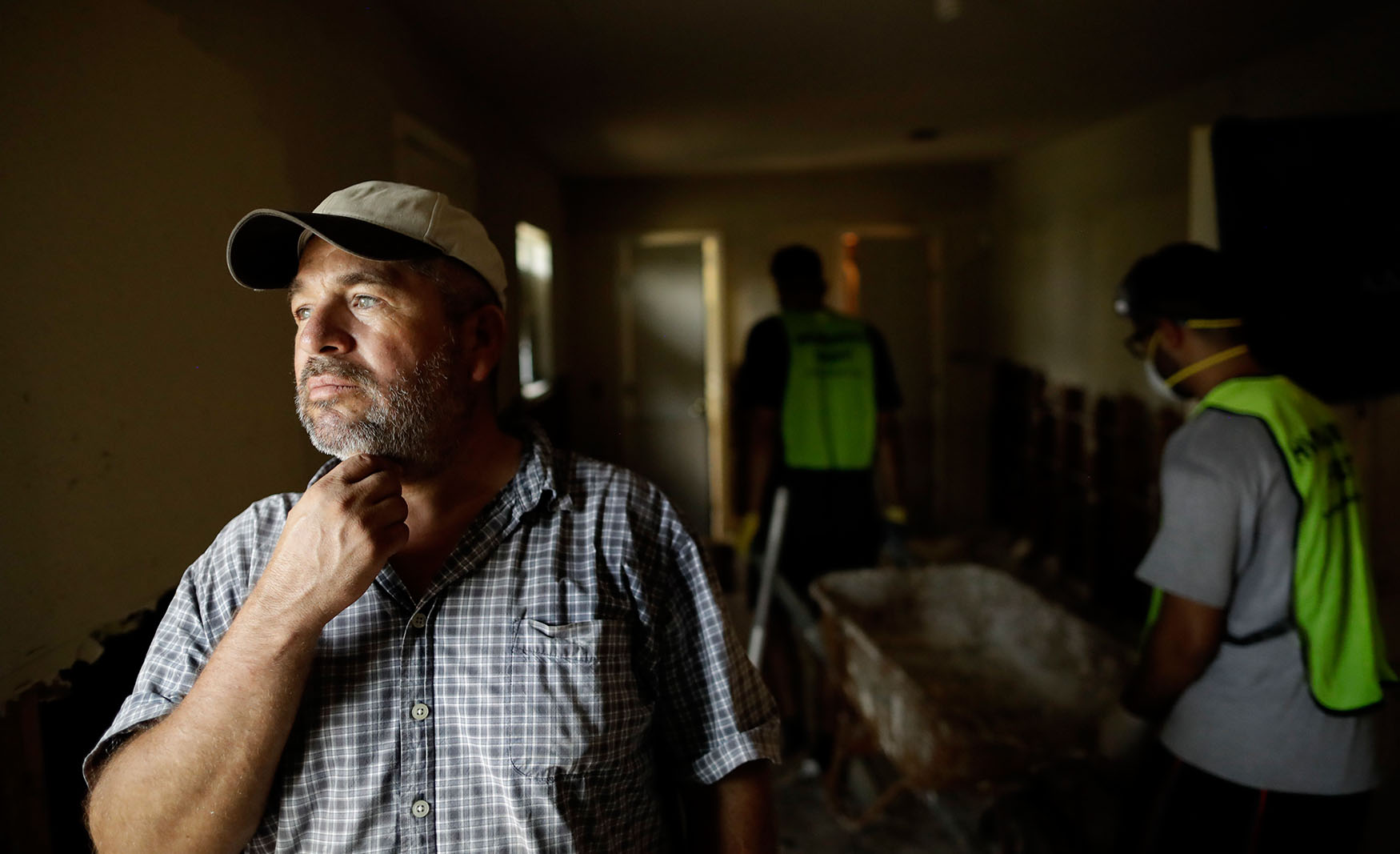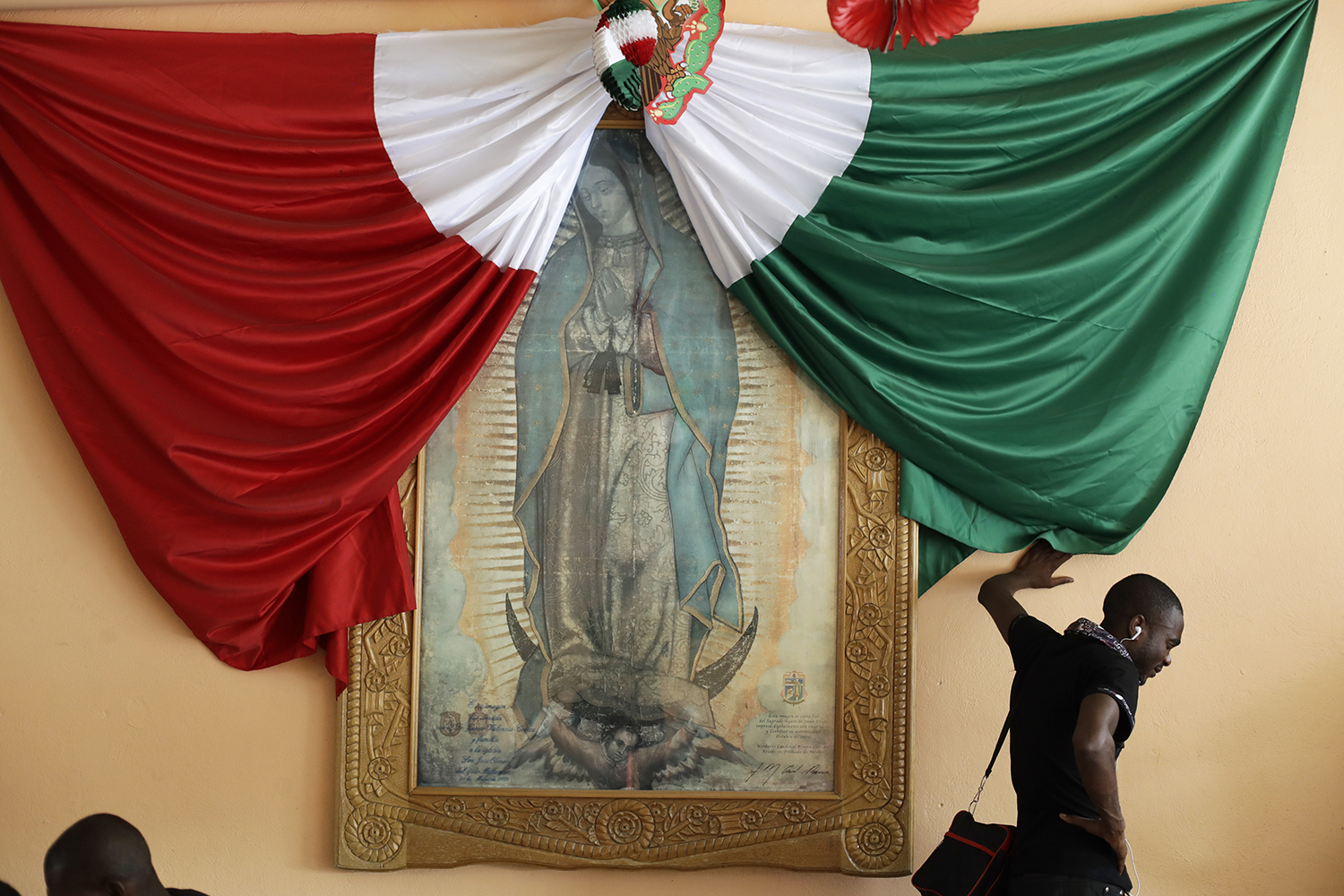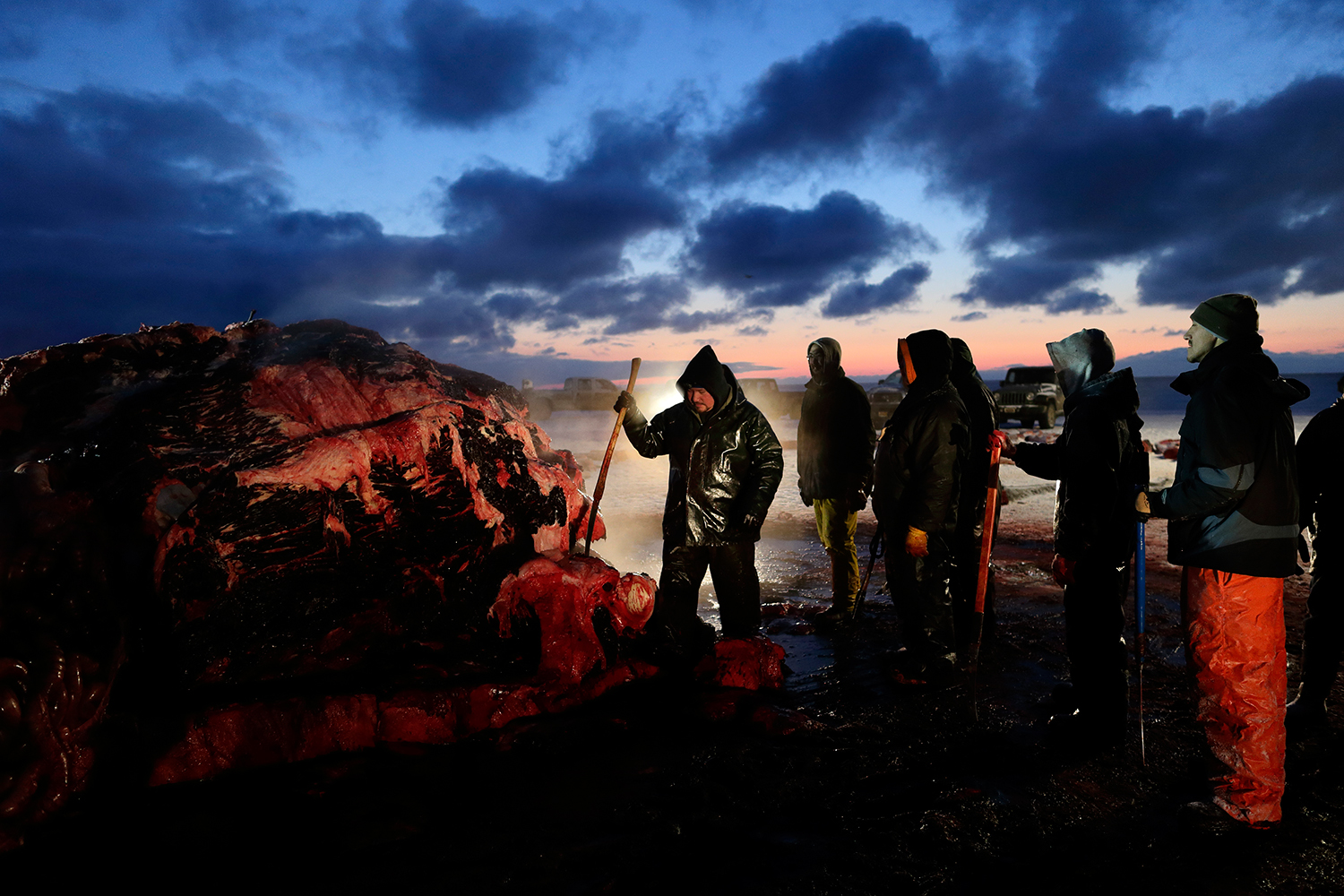AP Exclusive: How an ordinary ICE raid left behind a crisis

It had taken a decade for Brandon Tomas Tomas to establish a life in America: a wife, a steady job and five American-born children. It took 20 seconds for that life to be taken away.
An immigration officer looking for someone else spotted him and asked an innocuous question: “Cómo estás?” How are you? Then he asked whether Tomas had papers. In a flash, the 33-year-old Guatemalan was in handcuffs, in the custody of U.S. Immigration and Customs Enforcement, headed to jail and probable deportation.
Many miles away from the U.S.-Mexico border, authorities are separating families in raids that target immigrants at home and at work, conducted in the name of public safety. Most of these raids go unnoticed outside of the communities affected, but they are integral to the Trump administration’s broader crackdown on immigration that is leading to more arrests, particularly of migrants with no criminal records.
Government agents detain suspects during an immigration raid in Castalia, Ohio. (AP Photo/John Minchillo)
This is the story of one such operation, and the lingering effects it had not just on families but on the community they had come to call home. (Lea la historia en español aquí .)
Over two days in five towns across northern Kentucky, agents staked out homes before sunup, stopped men heading for jobs, went to warehouses like the one where Tomas had worked for more than a year. By ICE’s accounting, 20 men and two women were picked up.
Families barely getting by lost their only breadwinner. Left-behind wives didn’t know how to hire a lawyer or how they would afford bonds. Volunteers passed out cash so that bills got paid. Children needed meals, clothes and rides to school, and one school consultant says three students came to her, talking about suicide.
Even now, more than six months later, a boy, 4 years old, screams if he can’t find his father, terrified he’s been taken away again.
Two women cross a street in Covington, Ky. (AP Photo/Gregory Bull)
___
The operation occurred a few weeks before Christmas. ICE wouldn’t release the names of those taken into custody; a press release said only that “most” of the people targeted had prior criminal histories. The agency summarized the cases of what it called the worst offenders. One had been convicted of assaulting a police officer and evading officers. Another had a conviction for fraud by impersonation and a record of driving under the influence. A third had multiple DUI convictions.
The Associated Press found others arrested during the operation or soon after who weren’t apparent public safety threats, some of whom ICE encountered while looking for others. According to court records, lawyers and advocates, at least five were charged after the operation with crimes that relate to being in the U.S. illegally, including using fraudulent documents to get work, and eight people were eligible for bond, meaning they are not considered a danger to the community.
Among those apprehended and now out is Edgar Perez Ramirez. One afternoon recently, Perez is standing outside when his 4-year-old son darts down the sidewalk, shrieking because he thinks his father has disappeared again. The boy stops, panting, fighting to calm himself down, until his mother, Carmelinda, comes down the stairs and tries to reassure him: “Tu papá está aquí.” Your father is here.
Carmelinda Perez tries to sooth her crying son, Franco, after he ran out of the house looking for his father in Florence, Ky. (AP Photo/Gregory Bull)
Several thousand immigrants have settled in northern Kentucky, opening restaurants that serve Guatemalan pollo dorado and attending Spanish-language Mass. Like many of them, Perez and Carmelinda came here from indigenous communities in San Marcos, Guatemala. San Marcos is a transit point on the route to the nearby Mexican border. Human and drug traffickers operate with impunity, and gangs fight for territory.
“There wasn’t a day that you stopped hearing about deaths,” Perez says.
One day, about a decade ago, a knife ended his father’s life. Perez’s two brothers had already made their way to Kentucky and so, with the services of a trafficker, Perez took buses through Mexico and walked across the Sonoran Desert. Carmelinda soon joined him. Two children, both born in Covington, followed.
The family found their place here, making a home in two rooms of a row house filled with immigrant families who all share a kitchen and one bathroom. They joined a church, and took their children to play in a nearby park that features a glockenspiel clock, inspired by an earlier wave of immigrants from Germany. Perez got a job inspecting and repairing wooden pallets.
Edgar Perez Ramirez stands with his 4-year-old son, Franco, in their home. (AP Photo/Gregory Bull)
In December, it was still dark out when a car pulled up in front of Perez’s own as he headed for work. At first, the ICE agents asked about someone else. Then they inquired about his status, learned he was in the U.S. illegally and took him to jail.
Immediately after, Carmelinda stopped leaving the house to buy food. Their son, Franco, stayed home from preschool for 15 days because his mother was afraid to take him. She told the boy that his father had gone away for work. Eventually, Franco started to ask why his father hadn’t come home.
Six weeks later, an immigration judge agreed to release Perez on bond, because he didn’t have a criminal record. His brothers and friends chipped in for the $2,000.
Perez considers himself lucky, because he was able to return to his family for now. But what did he come home to, exactly?
Most days, Carmelinda stays shut up in the apartment with their 1½-year-old daughter, too scared still to go to the grocery store or ride the bus. Perez finds work where he can, but, he says, “We continue with fear.”
Franco Perez walks near his mother, Carmelinda, in their apartment in Covington, Ky. (AP Photo/Gregory Bull)
His son is most scarred. Franco no longer cries in a corner at preschool, the way he did after his father first was arrested, but his teacher says he shows more aggression toward classmates. At home, the boy panics whenever he loses sight of his dad, even when Perez leaves to use the bathroom.
The child sees a therapist, who advises Perez and Carmelinda to let him express his emotions in whatever way he can. So the couple let Franco draw on the walls of their bedroom. Squiggles in marker are everywhere. Most of the drawings are unintelligible, but there are a few recognizable scenes.
One is the face of the clock tower at the park the family used to visit, before they were terrified to leave the house.
___
In a conservative region of a conservative state, no public officials complained after the arrests. But quietly a crisis unfolded, reaching into courtrooms and churches, local businesses and schools.
Children play at recess at John G. Carlisle Elementary School in Covington, Ky., on April 27, 2018. At least three students here had a parent arrested in December when ICE agents arrested people in Covington and four other cities. (AP Photo/Gregory Bull)
As a leader of the local Immigrant Dignity Coalition, Don Sherman tried to help. A retired attorney who has lived in the region three decades, Sherman found lawyers to take cases and started handing out grocery store gift cards. He recalls going empty-handed one day to visit an immigrant family. When he left, two children came running after him. They wanted to know if he had any food.
By his count, those arrested had 19 children, most of them U.S. citizens.
At John G. Carlisle Elementary in Covington, two students in the fourth and fifth grades showed up with an adult cousin early one morning after the raid. Their father had been arrested. School social worker Kerry McHugh arrived to find the fifth-grader visibly shaken.
McHugh soon realized the family had almost nothing to eat. She enlisted the help of her friend, Mayra Sidler, who had worked as a school interpreter. One of the children told Sidler: “We’ve been eating eggs for days.” They dropped off chicken, rice, fruit and toilet paper, and McHugh has kept an eye on the family ever since. For one school assignment on hopes for the new year, the fifth-grader wrote that he wanted his father to come home.
School social worker Kerry McHugh talks to children at John G. Carlisle Elementary School in Covington, Ky. (AP Photo/Gregory Bull)
McHugh jokes that she’s a “stupid white girl” who learned about immigration on the job. About 520 of Covington’s 3,700 students are Latino, roughly 14 percent. There’s no way to know how many students were directly affected by the ICE arrests; at least three were held out of class initially at McHugh’s school. Local superintendents declined to comment or did not respond to messages.
Linda Vila Passione is a school consultant and immigrant advocate. She started hearing from parents who wouldn’t attend after-school meetings or take their children to activities. Then she began to see trouble in her home visits to families.
“I have three 10-year-old girls who have already threatened suicide,” she says. Another teenager told his mother, “What’s the use of going to school?” and had to be given antidepressants.
Frustratingly, she says, some school officials didn’t even seem to know about the operation. Vila Passione remembers telling one teacher about the arrests and the response: “What do you mean? There were raids?”
A few miles outside Covington, at Cristo Rey Catholic Church, Sister Juana Mendez’s phone began ringing around 6:30 a.m. the first day of the raid. Women whose husbands had been taken were worried about paying their bills. Others who weren’t targeted feared they might be next.
A set of crosses are displayed for sale at La Guadalupana in Florence, Ky.. (AP Photo/Gregory Bull)
A fourth-grader worried that if he went to school, his parents would be gone when he got home. “He was saying, ‘Why does God allow all this to happen?’” Mendez says. The family is in counseling.
Mendez’s Sisters of Charity helped families with rent and bills, and in January, some 80 people gathered at Cristo Rey to learn how to prepare for an arrest — in part by designating legal guardians for their American-born children in case of deportation.
Parents arrived with folders and grocery bags stuffed with birth certificates, passports, immunization records. Lawyer Alex Lubans-Otto stood ready to answer questions. A notary was on hand, too, in case any parents wanted to immediately complete the guardianship paperwork. Lubans-Otto remembers the long line that formed and, months later, begins to cry describing the scene.
“I still get upset about it because I can’t imagine,” she says. “They’re expecting to be taken from their children. It’s horrifying.”
___
South of Covington, the tobacco farms and horse ranches that originally attracted immigrants have given way to steel-walled factories and warehouses. American flags are on display alongside those of each parent company’s home base: Germany, Mexico, South Korea.
A poster announcing available jobs hangs in the window of the store La Guadalupana in Florence, Ky. (AP Photo/Gregory Bull)
Inside one building is Win.It America, a subsidiary of a Chinese company that ships items like car parts and lightbulbs for eBay. Win.It specializes in same-day fulfillment: Orders in by noon are out by 5 p.m.
Rick Vaughn helped open this warehouse and expand it, and immigrant labor has been a critical part of that growth. Of his 120 employees, he estimates as many as 80 are native Spanish speakers, mostly from Guatemala, Mexico and Puerto Rico.
“We do like immigrants because they work hard. They appreciate the work, and we appreciate them,” Vaughn says, standing on the warehouse floor one morning. Around him mechanical cranes whir, hoisting employees looking for products on towering shelves.
One of his best workers was a man he knew as Richard Rosario, who had been at Win.It for more than a year. He didn’t miss work, his English was good, and he trained others. But Rosario’s real name was Brandon Tomas Tomas. He had entered illegally at least a decade ago and was working on fraudulent papers.
An employee sorts through boxes at the Win.It America warehouse in Walton, Ky., on May 1, 2018. After an ICE agent arrested one of the company's employees, the warehouse lost 28 workers over several weeks and struggled to meet its shipping deadline. (AP Photo/Gregory Bull)
Vaughn didn’t know there had been a raid until he was called to the main office. He found Tomas pinned against the wall by ICE agent Joseph Phelps, who’d gone to Win.It looking for someone else. According to court records, Phelps struck up a conversation with Tomas and began asking whether he was in the country legally. Tomas was handcuffed and taken away.
The impact was immediate. Twelve employees quit over the next two days, and another 16 left over the next several weeks. Many of them, according to Vaughn, were U.S. citizens or green card holders but were afraid nevertheless of being detained themselves. Two weeks later, ICE did arrest another employee, a mother of three.
At the height of the Christmas rush, Win.It started missing its shipping deadline. As delays mounted, Win.It lost orders.
“We’re just getting close to being normal and back to where we were,” says Vaughn, who estimates he went through about 200 people to find sufficient replacement workers. Before the raid, he says, he counted on four staffing companies to ensure all referrals were in the U.S. legally. Now he double-checks, looking for signs of fraud.
People march in support of immigrants during a May Day rally in Cincinnati. (AP Photo/Gregory Bull)
Vaughn says he never suspected Tomas was in the U.S. illegally, in part because of his English, and he’s not happy he was misled.
But in the aftermath of the raid, Vaughn says, “Maybe it should be handled differently.”
“I think there should be a different strategy than going into stores or places of business and arresting people because they’re suspect,” he says. “If they’re not legal, there needs to be a way to get them legal ... if they are law-abiding, good, hardworking people. I think they should have an opportunity in America.”
___
Many who live in northern Kentucky support tougher immigration policies. “I’m all for people making a better life in the United States, and I know that’s why they come here,” says Jessica Penney, a nurse whose German mother married an American serviceman. “If you want to be here, just do it legally.”
And ICE itself defends the job it is doing.
“Do I feel bad about the plight of some of these people?” Thomas Homan, the agency’s acting director until his recent retirement, said in an interview with the AP. “I certainly do. I’m human. I’m a father. But I have a job to do.”
Thomas Homan, the recently retired acting director of U.S. Immigration and Customs Enforcement, greets border patrol agents along the border with Tijuana, Mexico, in San Diego. (AP Photo/Gregory Bull)
Homan credits Trump for empowering his more than 20,000 employees, arguing that tougher enforcement is necessary for public safety — that an immigrant in the U.S. illegally, even if that person is working and supporting a family, is flouting American laws.
Operations like the one in Kentucky are not new. ICE conducted at least four in Kentucky under the Obama administration, which in its early years arrested far more people annually than the Trump administration so far. Obama officials later instructed ICE to prioritize arresting immigrants who had committed serious crimes, were considered national security threats, or had been ordered recently to leave the country for immigration violations.
An executive order issued by Trump five days after he took office changed that. It effectively declared any immigrant in the U.S. illegally subject to arrest. Immigrants started to get apprehended at what they thought would be routine administrative check-ins or, like Perez and Tomas, by agents looking for someone else.
A man walks by a framed poster of a U.S. flag inside the Tercer Dia restaurant in Covington, Ky. (AP Photo/Gregory Bull)
By October, ICE’s administrative arrests had increased 42 percent over the previous nine-month period. This May, ICE said it had arrested some 80,000 people from October to March. Thirty-three percent were considered noncriminal, compared with 21 percent of the 63,000 people arrested the same months a year earlier.
A broader crackdown on immigration is leading to more arrests, particularly of migrants with no criminal records.
With little reason to believe the arrests are going to stop, many who live and work among immigrants continue to weigh how their communities should respond.
McHugh, the school social worker, recalls asking administrators to acknowledge the arrests and provide employees with guidance. An assistant superintendent sent out a memo with four bullet points, the first in bold: “Reassure students and parents that children are safe at school.” Neither McHugh nor her friend Sidler feels that was enough.
“It was the perfect time for the school to develop something, at least a plan. If something happens, these are the people that you have to inform,” Sidler says. “Nothing happened.”
“They didn’t take it seriously enough,” adds McHugh.
Advocates like Don Sherman are out of money now, and plans to build stronger networks within the community have stalled, so many don’t feel prepared for the inevitable operations to come.
Don Sherman of the local Immigrant Dignity Coalition talks to a Guatemalan immigrant outside a home in Florence, Ky. (AP Photo/Gregory Bull)
“We’re not ready for it. We all feel it, and we don’t know how exactly to address it,” says Jeff Richardson, a businessman who first heard of the arrests on Facebook and gave roughly $20,000 of his own money to help pay for court bonds. “So we have meetings, and we have another meeting, and we all feel bad because we didn’t accomplish enough since the last meeting.”
“We don’t know what’s going to happen in the future,” says Sherman, “because we’re still dealing with four or five families that really don’t have the person who’s a breadwinner at home.
“We’re doing what is like a triage ... and there’s still a lot of suffering.”
___
Alma Vazquez prays as she holds one of her five children at the Tabernacle Bible Church in Fairfield, Ohio. (AP Photo/Gregory Bull)
Most of the families that had someone arrested have little hope of being reunited here, so they have started thinking about a future outside of the U.S.
Alma Vazquez is Tomas’ wife. Though he’s from Guatemala, she’s from Mexico. They met working at a Brazilian restaurant.
She speaks clearly and deliberately about her family’s situation. Tomas, who had one prior deportation, has been charged with making a false claim to citizenship. He pleaded guilty, and remains jailed until his sentencing in August.
Their three older children get therapy in school. Vazquez watches the youngest, ages 1 and 3, during the day.
Holding her youngest son, Alma Vazquez stands next to her stepdaughter, Neveah Tomas, as she sings a song at a church event in Fairfield, Ohio, on April 28, 2018. A cousin who sometimes cares for the children told Vazquez that she recently heard them saying that if their father was deported, they'd have to leave the country, too. (AP Photo/Gregory Bull)
Sometimes, the family goes to see friends at the Tabernacle Bible Church, where Tomas was the treasurer and joined groups of volunteers who took food to the homeless. They are making do, but everyone realizes their lives may change again soon. Vazquez’s cousin told her she overheard one of the kids saying, “If my dad goes ... we’re going to have to go with him.”
The children have never visited Mexico or Guatemala. In either country, they’d likely be marks for gangs that assume people returning from the United States have money. But for Vazquez, getting her husband back and keeping her family together is all that matters.
“I tell them it’s our turn,” she says, “because your father is going to go. If you want to be with your father, you have to go to him.”
___
Associated Press journalists Gregory Bull and Manuel Valdes contributed to this report from Kentucky. Also contributing were Kate Brumback in Atlanta; Dylan Lovan in Louisville, Kentucky; John Minchillo in Cincinnati; and Sonia Perez D. in Guatemala City.
___
Text from the AP news story, AP Exclusive: How an ordinary ICE raid left behind a crisis, by Nomaan Merchant.
Photos by Gregory Bull and John Minchillo
Lea en español aquí .
Visual artist and Journalist






